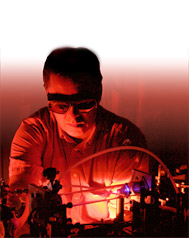About LANL
About Our Capabilities, Facilities, and Staff
"Los Alamos National Laboratory plays an indispensable role in building America as a science and technology powerhouse, and our staff are an incredible resource to the nation and the world." Michael Anastasio, Dir.
Solving Complex R&D Problems with Special Blend of Staff, Capabilities and Facilities
Now in its seventh decade, LANL remains among a very few laboratories that can bring great breadth of fundamental and discovery science, technology, and engineering rapidly together to create tangible solutions for national security needs.
Our staff, working with partners throughout science and industry, must be able to deliver today's solutions while maintaining the depth of capabilities to deliver the next generation of discoveries.
Los Alamos has demonstrated a cycle of innovation where we have developed world-leading capabilities and facilities in response to urgent, unique missions. We also spin out new discoveries that lead to emerging missions.
Being able to integrate and apply our capabilities rapidly to new challenges will be a key advantage in an increasingly competitive landscape.
Our Science, Technology and Engineering Priorities
Science that Matters
- Information science and technology enabling integrative and predictive science
- Experimental science focused on materials for the future
- Fundamental forensic science for nuclear, biological, and chemical threats
How We Work
- Collaborate, partner and team to make decisive contributions to our sponsors
- Outstanding operational excellence for safety, security, and efficient pursuit of ST&E for our missions
Transform Our Scientific Campus
- Campus for 2020 (consistent with complex transformation)
- Modern science facilities: LANSCE refurbishment, CMR replacement, Science Complex
- Signature facilities for experimental science (MaRIE) and computational science (Roadrunner)
More About This Science
Nanostructuring Metals to be Simultaneously Stronger and Damage-resistant
Nanolayering Improves Materials
Stronger, lighter materials increase security and efficiency

Quick read
Lab scientists have discovered how to layer metals to make them stronger and lighter, improving cars, airplanes, computers, and nuclear power plants.
Nations worldwide are striving to replace traditional fossil fuels with cleaner, more abundant power sources. Recently, the Department of Energy concluded there is one common need to all future energy technologies: improved materials.
To meet that need, lightweight materials that resist corrosion, decay and failure—and that heal themselves—are being developed at Los Alamos National Laboratory (LANL).
These improved materials will also make our cars, airplanes, computers and power transmission lines lighter, stronger and more damage-resistant. "Of course, if an aircraft or automobile is lighter, it will decrease fuel costs," says Amit Misra of the Center for Integrated Nanotechnologies (CINT) of the Lab’s Materials Physics and Applications (MPA) division.
Making Metals Thinner and Stronger
Misra, who recently won the LANL Fellows Prize for his research, is nanostructuring metals that are simultaneously stronger and damage-resistant. His team’s new technology combines two metals into a composite made up of ultra-thin layers; this nanolayering makes the composite extraordinarily strong and highly damage-resistant.
"The nanolayered composites have strengths that are over two orders of magnitude higher than high-purity metals in the single crystal form," Misra says.
In contrast to nanostructured materials, conventionally-engineered steel, aluminum, copper and other metals have low strengths and poor damage tolerance. In order to withstand high loads or extreme environments—high pressure, soaring temperature or long-term radiation—engineers must overdesign the structural components, for example, making a metal container thicker and heavier.
Making Power Plants Safer
Fossil fuels are scarce and efforts to curb greenhouse gases are increasing. Clean power sources such as nuclear power plants can help meet the world's future energy needs, but safety and economical concerns remain. According to the U.S. Nuclear Regulatory Commission, the 1986 accident at the nuclear power station in Chernobyl, Ukraine may ultimately cause approximately 4,000 radiation-related cancer deaths of its workers and residents.
In a nuclear power plant, constant exposure to radiation degrades the structural materials over time. For example, the metal containers used to hold nuclear fuel can experience radiation-induced swelling and creep (deformation). The swelling is caused when helium-filled cavities produced by radiation inflate inside the metal. Currently, engineers design around these limitations. The containers are made very thick, and the components are replaced frequently, making the process expensive and dangerous.
The Lab's research—which will help to design structural materials that better withstand the degrading effects of radiation—could help address those concerns.
Interfaces Protect Against Radiation Damage
The new nanolayered composites could dramatically improve the performance and reliability of materials in nuclear reactors. The key to damage resistance is the interface, or junction, between the layers in the composite. When the right kinds of metals are bonded, the interface between them has unprecedented, self-healing properties. The interfaces attract, absorb and annihilate radiation-induced defects.
Because the attraction of defects to interfaces only works when an interface is close to a damaged area, very thin nanolayers—just a few dozen atoms thick—must be used.
The right combination of metals is key. The combination of Copper and Niobium works well, Misra says; this combination produces the remarkable tolerance to radiation damage as well as the very high strength characteristics of nanolayered composites. "This is one combination, but is it the best one?" Misra says. "We don't know yet."
More research is needed to find the ideal materials that will help build tomorrow's power plants, cars, airplanes, computer components and electrical transmission lines, Misra says. The technology is still in the early development stages but the Laboratory is on the cutting edge for materials that enhance our lives.

Table-top lasers compete with large accelerators
George Rodriguez adjusts argon gas pressure inside two-color plasma ionization gas cells
Table-top ultrafast laser based plasma terahertz sources are beginning to rival pulse energies previously obtainable only at large accelerator-based facilities.
Currents, the Laboratory's monthly employee magazine, highlighting people in the workplace.







